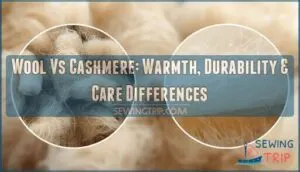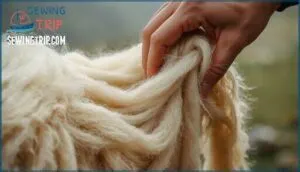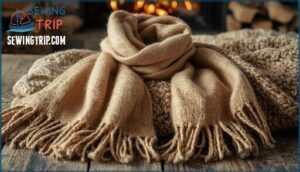This site is supported by our readers. We may earn a commission, at no cost to you, if you purchase through links.

Beyond cost, the real distinctions lie in fiber diameter, thermal efficiency, and durability. Cashmere measures 14-19 microns across, making it considerably finer than wool’s 19-25 microns. This microscopic difference creates noticeable changes in softness, warmth, and how each material performs over time.
Understanding these contrasts helps you choose the right fiber for your needs, whether you’re prioritizing lightweight insulation, long-term durability, or everyday comfort.
Table Of Contents
Key Takeaways
- Cashmere provides up to 8 times more warmth than wool at the same weight due to its finer fiber diameter (14-16 microns vs. wool’s 19-25 microns) and hollow structure that traps air more efficiently.
- Wool demonstrates significantly greater durability, lasting 20-30 years compared to cashmere’s 10-year lifespan, because its thicker fibers withstand over 20,000 abrasion cycles versus cashmere’s fewer than 10,000.
- Cashmere costs roughly 30 times more than wool due to extreme scarcity—each goat produces only 150 grams of usable fiber annually, requiring 4-6 goats for a single sweater—while global wool production exceeds 2 million tons.
- Wool retains its insulating properties when wet (holding up to 30% moisture without losing warmth) and gains resilience in moisture, while cashmere loses 30% of its strength when wet, making wool better for harsh or damp conditions.
What is Wool?
Wool is a natural fiber that comes from the fleece of sheep, though you’ll also find it from goats, alpacas, and rabbits. Fundamentally, wool composition centers on keratin, a fibrous protein made up of 18 amino acids. This protein structure gives wool its unique properties, including superior moisture absorption and natural elasticity.
The fiber structure of wool features tiny crimps, scales on the surface, and a complex arrangement of chemical bonds. Merino wool, prized for its softness, contains up to 30 crimps per inch, while coarser wool types have just one or two. These crimps trap air between fibers, creating natural insulation. Wool’s strength and elasticity are due to its unique chemical bonds.
Wool production reaches about 1.7 million tonnes globally each year, with Australia and China leading the way. Different wool types vary in texture and warmth based on the animal source and fiber diameter, which ranges from 17 microns in fine Merino to 40 microns in coarser varieties.
What is Cashmere?
Cashmere originates from the soft undercoat of cashmere goats, scientifically known as Capra hircus. You’ll find this fiber carefully combed from the goats during their natural spring molting season, when they shed their winter insulation. Unlike regular wool from sheep, cashmere fibers measure just 14–19 microns in diameter, making them exceptionally fine and soft against your skin.
Here’s what makes cashmere special:
- Production Yield: Each goat produces only about 150 grams of usable fiber annually, so you’ll need fleece from 4–6 goats just to make one sweater.
- Thermal Characteristics: Cashmere provides up to 8 times the warmth of sheep’s wool at the same weight, thanks to hollow fibers that trap air pockets.
- Fiber Properties: The fibers can absorb one-third of their weight in moisture without feeling damp, offering natural temperature regulation.
- Global Market: China and Mongolia produce over 90% of the world’s cashmere supply, with global production reaching approximately 2,632 metric tons in 2024.
That’s why cashmere commands premium prices and remains a luxury textile choice. The softness is due to cashmere’s fine texture.
Key Differences
When you compare wool and cashmere, the differences between them become clear through several key fabric properties comparison metrics. Fiber diameter stands as the primary distinction: cashmere measures 14–16 microns, while wool ranges from 19–25 microns. That’s why cashmere feels softer against your skin—the finer the fiber, the gentler the touch.
Production volume reveals another contrast. Global wool output exceeds two million tons annually, but cashmere production hovers around just 15,000–20,000 tons. Each cashmere goat yields only 150 grams of usable fiber per year, requiring four goats for a single sweater. Goat breeds matter here—cashmere originates exclusively from Kashmir goats, while wool comes from various sheep breeds.
Consider these key contrasts:
- Warmth – Cashmere provides 3–8 times the insulation of wool at equal weight
- Fabric weight – Cashmere achieves warmth at one-fifth the weight of wool
- Lanolin content – Wool contains natural lanolin; cashmere doesn’t, making it hypoallergenic
- Durability – Wool demonstrates greater tensile strength and maintains shape longer
Your choice depends on balancing warmth against longevity.
Which is Warmer?
When you’re picking between wool and cashmere, warmth becomes the deciding factor for many. Cashmere delivers exceptional insulation—up to seven or eight times warmer than merino wool at the same weight. This advantage comes from fiber diameter: cashmere measures just 13–16 microns, while wool ranges from 19–24 microns. Those finer fibers trap more air per unit volume, creating better thermal conductivity resistance.
The warmth of wool and cashmere differs because of how each fiber evolved. Cashmere goats develop their undercoats in subzero Mongolian winters, resulting in hollow-structured fibers perfectly adapted for air entrapment. Comparing wool and cashmere in lab tests shows cashmere’s thermal resistance hits 0.42 clo versus wool’s 0.34 clo. That wool vs cashmere warmth comparison reveals cashmere maintains your core body temperature about 1.5–2°C higher at equal fabric weight.
Cashmere’s hollow fibers trap air more efficiently than wool, delivering eight times the warmth at equal weight due to evolved insulation from subzero Mongolian winters
Material warmth and comfort depend on your needs, though. Wool retains wet warmth better, holding up to 30% of its weight in moisture without losing insulation—essential for damp conditions where cashmere’s climate adaptation falls short.
Which is More Durable?
When you’re weighing your options, fiber strength becomes the deciding factor. Wool’s thicker diameter—19 to 25 microns versus cashmere’s 14 to 16—gives it greater tensile strength and pilling resistance. Merino wool endures over 20,000 abrasion cycles before visible damage, while cashmere shows wear after fewer than 10,000. That’s why wool garments last 20 to 30 years with proper care, compared to cashmere’s 10-year lifespan.
Durability and longevity contrasts extend to everyday stress factors too. Wool’s crimped structure recovers from compression better, maintaining its shape through repeated washing. Cashmere pills 30 to 50% more often during casual wear due to fine fiber friction. For use cases involving high-friction activities—coats, suits, heavy sweaters—wool’s 20 to 40% higher fiber resilience makes it the practical choice. Cashmere shines in low-wear luxury items like scarves, where its softness outweighs durability concerns.
Caring for Wool
With proper maintenance, your wool garments can serve you for decades. Start by checking the care label—some wool should be dry cleaned, while others can be washed at home. Superwash wool tolerates machine washing on gentle cycles using cool water below 40°C, but hand-washing works best for most woolens. Use water no hotter than 30°C with a mild, bleach-free detergent to prevent fiber damage and shrinkage.
For effective cleaning and longevity:
- Washing wool: Gently squeeze suds through the fabric rather than agitating, then roll in a towel to remove excess moisture before air drying flat at room temperature.
- Stain removal: Blot spills immediately with cold water—hot water above 50°C causes irreversible felting and sets stains permanently.
- Wool storage: Keep garments in breathable bags with cedar blocks to deter moths, and rest pieces 24 hours between wearings so fibers recover naturally.
Press using steam at medium heat with a cloth barrier. Regular brushing removes surface soil, and sunlight exposure discourages moth larvae.
Caring for Cashmere
Your cashmere pieces deserve gentle attention to maintain their luxurious softness and warmth for years ahead. Since cashmere fibers measure just 14-16 microns in diameter, they’re remarkably delicate compared to regular wool and need careful handling to prevent damage. Wash your cashmere every 5-6 wears for occasional use, or every 3-4 wears if you wear it frequently, using cold or lukewarm water with a detergent specifically formulated for delicates.
Follow these washing instructions for proper care:
- Hand wash gently in cold water, then press out moisture with a towel instead of wringing or twisting
- Dry flat in the garment’s natural shape away from direct sunlight to prevent stretching
- Fold and store in breathable cloth bags with cedarwood or lavender to deter moths
- Remove pills carefully with a cashmere comb to maintain the delicate garment’s appearance
Spot clean minor stains promptly with mild detergent rather than washing the entire sweater, which greatly extends your cashmere’s lifespan.
Itchiness Solutions
That prickly feeling from wool doesn’t have to ruin your winter wardrobe. Fiber diameter plays the biggest role in comfort—Merino wool fibers measure less than 22 microns in diameter, while standard wool can exceed 30 microns, making it much more likely to irritate your skin. Cashmere’s ultra-fine 14-16 micron fibers rarely cause problems, but quality matters. Look for long-staple cashmere with tight weaving, which presents fewer exposed fiber ends.
True wool allergies are rare—less than 5% of reactions are actual immune responses. Most discomfort comes from physical irritation, not allergy. Cold water rinsing tightens fibers for smoother surfaces, while wool-specific detergents preserve natural oils that maintain softness. For persistent sensitivity, hypoallergenic fabric blends offer comfort without sacrificing warmth.
| Solution Type | Method |
|---|---|
| Washing techniques | Soak in white vinegar solution for 15-20 minutes, or use hair conditioner in lukewarm water for 30 minutes to soften fibers |
| Fabric selection | Choose Merino wool, high-quality cashmere, or Woolmark-certified products for assured fiber quality and softness |
| Medical treatments | Use antihistamines or corticosteroid creams for allergy symptoms; consult a doctor if hives or breathing difficulty occur |
Choosing Wool or Cashmere
Choosing between wool and cashmere depends on what matters most to you. Each fiber offers distinct advantages that suit different needs and budgets.
Let’s look at three key factors that’ll help you make the right choice.
Warmth Versus Durability
When you’re choosing between these fibers, thermal efficiency and abrasion resistance pull you in different directions. Cashmere delivers roughly eight times more warmth than standard wool under equal weight, thanks to its fine, hollow fibers that trap still air like natural insulation chambers. That’s why you’ll find cashmere ideal for lightweight sweaters and scarves in frigid weather.
Wool, however, brings enhanced fiber strength and durability to the table. Its thicker structure withstands repeated wear and washing, offering a garment lifespan of 15 years or more compared to cashmere’s 8 to 10 years.
For best use, choose cashmere when warmth comparison favors lightness and luxury, but pick wool when your clothing faces active wear or harsh conditions.
– Softness and Itchiness
Your skin tells the story before your mind does—cashmere feels like silk against bare skin, while wool can leave you scratching. Fiber diameter explains the difference: cashmere measures 14–16 microns compared to wool’s 19–25 microns, creating a smoother texture with less friction. Wool contains lanolin, a natural wax that triggers allergic reactions in 1–2% of people with dermatitis, while cashmere lacks this irritant entirely. For skin sensitivity, tactile perception clearly favors cashmere’s comfort.
Cashmere’s superior softness can be attributed to its structure:
- Softness stems from structure: Cashmere’s lack of a medullary layer creates uniform, supple fibers that glide across the skin.
- Lanolin content matters: Wool’s natural wax increases itchiness and allergy risk, especially for sensitive skin types.
- Pilling versus texture trade-offs: Cashmere’s fine fibers may pill over time, but wool’s rougher scales cause immediate micro-friction and discomfort.
– Production Cost Differences
Price disparities between cashmere and wool stem from material sourcing and production. Fiber acquisition costs differ sharply: virgin wool averaged 3,784 euros per ton in 2024, while combed cashmere reached 118,441 euros—roughly 30 times more expensive.
Processing expenses add another layer, as cashmere production requires intensive dehairing that increases finishing costs by 35–50% compared to wool’s mechanized operations. Labor costs and fragmented supply chains further increase cashmere prices, especially in China and Mongolia, where manual combing accounts for 60% of production cost per kilogram.
| Cost Factor | Wool | Cashmere |
|---|---|---|
| Fiber yield per animal/year | 3.5–4.5 kg | 150–200 grams |
| Raw material price (2024) | 3,784 euros/ton | 118,441 euros/ton |
| Processing cost increase | Baseline | 35–50% higher |
| Manual labor share | ~25% | ~60% |
| Market pricing markup | ~200% | ~400% |
Market pricing reflects this reality—cashmere garments command markups exceeding 400%, while wool generally doubles. You’re paying for scarcity, labor intensity, and exclusivity when choosing cashmere over wool’s cost-effective abundance.
Frequently Asked Questions (FAQs)
Can cashmere be machine washed safely?
Yes, you can machine wash cashmere safely using a delicate cycle with cold water and gentle detergent. Keep the temperature below 20°C and spin speed under 600 rpm to prevent shrinkage and protect the fibers.
Which fiber is better for allergies?
Contrary to popular belief, true wool allergies are rarer than finding a purple sheep. Cashmere is hypoallergenic because it lacks lanolin, which causes most wool sensitivities.
Fine-diameter wool, however, also suits sensitive skin well.
How long does cashmere typically last?
High-quality cashmere can last over 10 years with proper care. Durability depends on fiber length, micron count, ply count, and quality grades.
Maintenance matters—gentle washing and careful storage extend longevity. Lower-quality cashmere or poor caring for cashmere may reduce lifespan to 3-5 years.
What causes cashmere to pill so much?
Cashmere fibers are naturally delicate, with their fine diameter of 14-19 microns and smooth scale structure making them vulnerable to friction factors.
Mechanical stress from rubbing causes fiber ends to tangle and form pills, especially with shorter fiber length around 35-45 mm.
Is blended wool-cashmere worth the investment?
Blends offer a smart middle ground, giving you cashmere’s softness at a fraction of the cost.
A 70/30 or 80/20 wool-cashmere blend generally runs $11-28 per meter, compared to pure cashmere’s $150-740 per yard, while still delivering warmth and luxury feel.
Conclusion
Cashmere fabric loses roughly 30% of its strength when wet, while wool actually gains resilience in moisture—a detail that matters when washing delicate garments.
The wool vs cashmere difference ultimately comes down to what you value most: cashmere’s unparalleled softness and lightweight warmth, or wool’s rugged durability and easier care. Your lifestyle determines the winner. If you wear sweaters daily through rough conditions, wool withstands the stress. If you want luxurious comfort for special occasions, cashmere delivers that experience nothing else can match.
- https://snsilk.com/wool-vs-cashmere/
- https://www.linkedin.com/pulse/100-cashmere-sweater-actually-0-how-avoid-pitfalls-when-alisa-lee-oouhc
- https://cbcashmere.com/blogs/news/how-much-cashmere-is-produced-in-the-world-per-year
- https://dresslemuse.com/blogs/blog/cashmere-vs-wool
- https://fangyuanjackets.com/cashmere-vs-wool/













